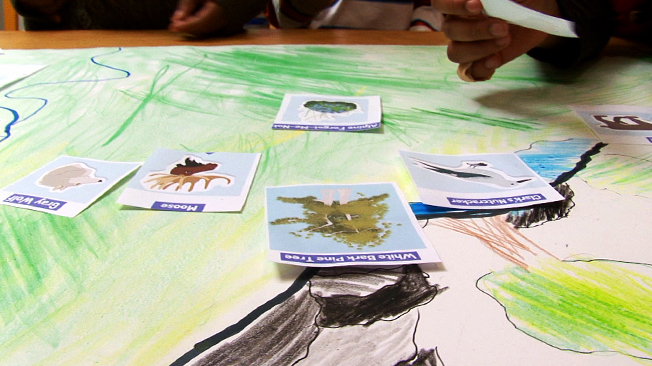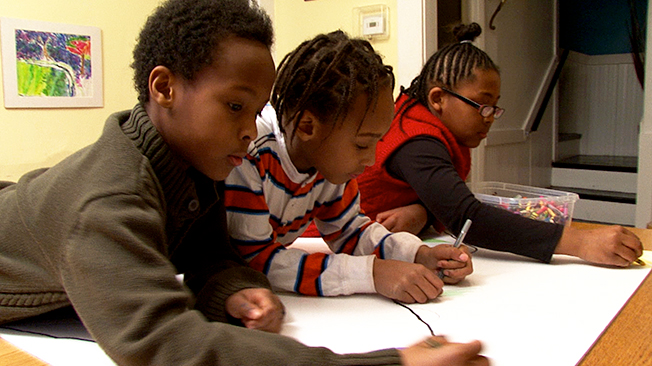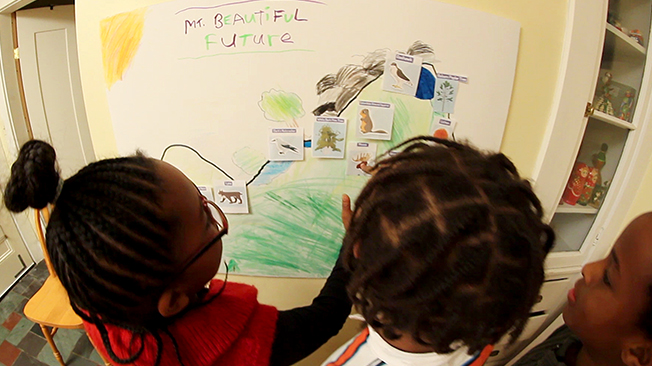Pin the Moose on the Mountain

What Is This Activity?
Where do you think you might be if you start your day strolling through a warm, leafy forest and end it walking on ice and snow? On a mountain! In this mapping activity, your child will explore the animals and plants that live on the different parts of a mountain.
Introduction
-
-
00:00
What Are Kids Learning?
- Living things need air, water, food, sunlight, and shelter. Living things can only survive in ecosystems in which their needs are met.
- Different areas support different kinds of living things, both on land and in water.
- Different locations on a mountain receive different amounts of sunlight and precipitation and vary in temperature.
- The plants and animals that live in a mountain habitat reflect the local climate, including rainfall and temperature.
Activity 60 minutes

Part A Imagine Mountains
Ask your child: Where might we be if we started strolling through a warm, leafy forest and ended up walking on bare rocks, possibly covered in ice and snow? If your child seems stumped, provide a hint: you would be walking uphill all day.
Then work together to draw the outline of a mountain on a large sheet of paper.
Ask:
- How do you think the top of a mountain looks compared to the bottom?
- What do you think the climate is like at the top of a mountain? The bottom?
- How might sunlight, temperature, and rain or snow affect the plants and animals on different parts of a mountain?
TIP: Your child might ask why it is colder at the top of a mountain than at the bottom, especially if he or she understands that warm air rises. As you go higher in elevation, air pressure decreases. When air pressure drops, so does temperature, which is why it is colder at the top of a mountain than at the base.
Part B Make a Mountain
Cut out the cards from the "Meet Us on the Mountain" handout. As you read each card, talk about where each organism might live on a mountain.
Ask:
- What does this animal need to eat?
- Where is its habitat?
- If it eats other organisms, what do those organisms need to survive?
- What do the plants need? Where will they find it?
- Does the card give any clues about where on the mountain the organism lives?
TIP: You and your child don't need to know exactly which kinds of plants an herbivore like a ground squirrel might eat—there are no "right" answers. Instead, think about which animals eat plants, which animals eat those animals, and which resources plants need to survive.
Draw the outline of a mountain on a large sheet of poster paper. Then draw the sun and show which parts of the mountain would be sunny and which parts would always be in the shade.
Using the cards as a reference, draw each plant or animal you would find in a mountain ecosystem. Make multiple drawings of each. Cut out these drawings, then glue or tape them to the parts of a mountain where you think each plant or animal lives. If you like, you could also build model plants and animals with craft supplies.
As you create the mountain, talk with your child about the relationships between the plants and animals.
Ask questions like:
- What might the wolf eat? What might the ground squirrel eat?
- What might happen if there are more wolves than ground squirrels?
- More ground squirrels than plants?
- What might happen if all the plants on the mountain disappeared?
- Are there more plants or more animals in most ecosystems? Why?
Explore Some More
Map Your World
Go for a walk around your yard, apartment building, or neighborhood. Identify different kinds of habitats. These might be open spaces such as sports fields, or parking lots; vegetation such as shrubs, flowers, or grass; or yards with trees or gardens in them. Predict what kinds of animals might live in each place, and jot down in your field notebook any animals you see. Remember, spiders, insects and worms are animals, too! How do the animals you see find food, water, and shelter? How do the plants survive? Back at home, make a map of your yard or neighborhood, drawing the locations of different habitats and listing the plants and animals you might find in each one.


